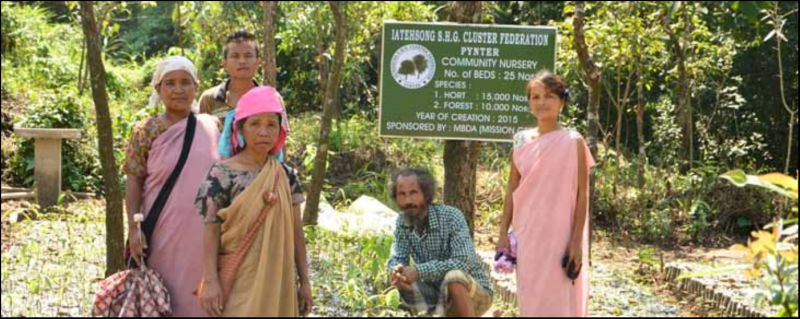
The Tehsonglang CLF was started in 2011 through the facilitation of Meghalaya Livelihoods Improvement Project for the Himalayas (MLIPH). Started under Iatehsong SHG Cluster Federation, it consists of 8 SHGs with a total of 70 members. Covering one village the CLF is well connected with an all-weather road which is 18 km from the district headquarters Pynsursla and 64 km from Shillong. Sumo services are available till Pynursla. The key source of livelihood activities in this area includes broom grass, betel-leaf, betel-nut, black pepper, wage-earning etc. This enterprise commenced work in April 2015 after discussions between CLF leaders and the IBDLP programme implementation team. The CLF got interested in this opportunity to both generate income and bring about afforestation in that area. The participating members are happy with the activity and the support provided by MBDA. Two of their members – Mr. Kynjri Ksiar Nongkrot and Mr. Kroli Khonglam - are also master trainers for community nurseries. The IBDLP Programme implementation team provides on field handholding support via periodic supervision and monitoring.
OPERATIONAL DETAILS
In the 6 months since it started its Community Nursery, the CLF has so far received Rs. 90,000 from MBDA. They have utilised the money in purchase of materials such as poly bags, plastic water tank, pipes and other miscellaneous equipment. Expenditure also includes payment of wages (at the rate of Rs. 200 per day for women and Rs. 350 per day for men). The 3 acres of land across which the Community Nursery is set up, was donated by Dorbar Shnong to the CLF specifically for this or similar activities and an agreement was signed between the two parties. The CLF leaders along with the master trainers manage all routine and decision-making activities. The master trainers have been assigned weekly monitoring duties, and consult the CLF leaders on issues of labour responsibilities and distribution of work for the nursery. Depending on the work requirements, each SHG is allotted a roughly equal number of representatives to send to the nursery farm such that every SHG is an equal participant in nursery activities and responsibility. Most of the species available in the nursery are hard wood trees used for timber and firewood- DiengJem, Sohphan, Lymbaw, Shinai, Bti, Jyrngem, Shatnud, Shyrngan, Dieng Siar, Dieng Bishna, Dieng Sohpreh, Dieng Sohrymwai. Other horticultural varieties of plants are expected to be added in the coming season. In a short span of time, the CLF has 25 beds filled with saplings of different species. About 17,000 saplings were sown initially, however due to excessive rain the saplings have reduced to about 13,500 at present. They have not started selling it yet; however, about 100 saplings were planted in village water catchment area during the World Environment Day 2015. Currently, CLF does not have contact with other agencies and solely depends on MBDA but soon it will be approaching Block Office, Line departments and neighbouring villages to increase the sapling production. At present the expected cost of the saplings is 13,500 x Rs. 8 = Rs. 1,08,000. However, the income may reduce if proper watering is not done during the dry season i.e. November to March.
INITIAL CHALLENGES
With all the developments there have also been challenges during the dry season as the soil is sandy. The nursery also requires good fencing to protect it from animals and children. Moreover, there has been low germination rate and high mortality rate due to excessive rain. The community shared that to solve these problems it was experimenting with using cow dung in the soil. Most of the CLF members are also only just learning the techniques of managing the plastic/polybags in the nursery, so increased experience is expected to contribute toward nursery success and plant health over time.
INSIGHTS FROM COMMUNITY INTERACTION
People in the CLF appeared confident that their enterprise would be successful and bring good income in the coming days with the support of MBDA/IBDLP. Even the non- participating members of the village appeared to support the activity. It is expected that in the coming years saplings of potential economic value and horticultural species will increase at the nursery and thus fetch the CLF a good income.